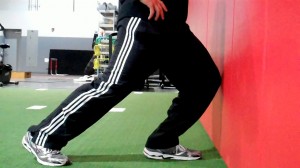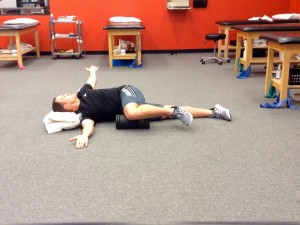Brian Schiff’s Blog
Injury Prevention, Sports Rehab & Performance Training Expert
Pectoralis minor tightness coupled with kyphosis often leads to postural dysfunction, limited thoracic mobility and shoulder problems. This can increase injury risk for overhead athletes, Olympic lifters and fitness enthusiasts participating in regular weight training.
This exercise is from one of my columns for PFP Magazine, and it can be integrated as part of a warm-up/movement prep session prior to engaging in overhead sports or lifting activities. In addition, it can serve as a daily corrective to improve shoulder mobility and posture. Finally, it can be used in recovery and the cool-down to address soft tissue tightness in the chest. When used post-workout, I suggest a slightly longer hold time to emphasize more passive stretching when force production is not a concern.
Click here to read the entire column including details on the execution.
This is a follow-up from my previous post. Limited thoracic spine rotation can be detrimental for the shoulders, low back and lower extremities with sports and strength and conditioning activity. Consider the impact of asymmetry or stiffness on a golfer, swimmer, thrower, tennis player or even someone doing rotational and pressing working the gym.
Asymmetrical and repetitive activity can lead to deficits as can faulty positions during work and daily life. This simple exercise with the foam roller can be helpful in facilitating optimal mobility and better kinetic chain motion. This video comes from my ‘Functionally Fit’ column for PFP Magazine.
I work with many weekend warriors, strength training enthusiasts and overhead athletes in my practice. One of the more common dysfunctions I see in this population is either asymmetrical or general thoracic spine hypomobility (decreased range of motion).
This can predispose you to shoulder, back and hip dysfunction, as well as increase the risk for overuse injuries. In addition, it may also alter the natural biomechanics of movement, thereby negatively impacting performance. With all the sitting and screen time we engage in, it is no surprise we are developing a generation of people with forward heads, rounded shoulders and kyphotic posture.
This leads to reduced thoracic spine extension. Additionally, I often encounter decreased thoracic spine rotation. If this becomes restricted, asymmetrical overhead athletes may face increased stress on the lumbar spine, hips and glenohumeral joint. Common dysfunctions I treat related to this is rotator cuff tendinopathy, labral pathology, mechanical back pain, and hip pain to name a few.
To combat stiffness and promote more optimal mobility, I encourage my clients to perform daily mobility work. I have included a video I filmed for PFP Magazine in my column ‘Functionally Fit’ below that illustrates an effective way to combat reduced T-spine extension.
Be sure to check back for my next blog post on how to increase thoracic spine rotation.
If you follow my blog, you may remember that about this time last year I posted some info about a compilation of body weight training resources. Well, a new version is back for 2015, and as a person who contributed to the project, I wanted to make you aware of the offering. It is available from today until March 27 at 11:59 PM and includes content from different disciplines within the health and fitness community.
Get the NEW Bodyweight Bundle 2.0 bundle here
It includes:
8 Bodyweight muscle building resources
6 Bodyweight fatloss programs
6 Bodyweight “trick” manuals
7 Bodyweight video/workout programs
4 Bodyweight flexibility/rehab programs (including my shoulder e-book)
Plus…
… fat-burning recipes, meal plans and more.
You can harness the power of bodyweight exercises from multiple experts to transform your body and your life. You can own all 37 resources for only $37 for a limited time! Click on the image below for more information.
This post is dedicated to improving mobility in two areas I commonly find restrictions in among my clients – the ankle and thoracic spine. Specifically, I often find limitations in dorsiflexion and thoracic spine rotation that create undue stress on other parts of the kinetic chain.

Standing wall touch
Recently, I wrote an article for the WeckMethod site on how to assess and improve ankle mobility. As a clinician and coach, I see this issue in many runners and athletes I work with. At times, it is joint restriction, while in other cases it is soft tissue limitations that impact mobility.
There are several potential reasons why one might possess less than optimal movement in the ankle. The most common causes include: joint stiffness following injury and/or immobilization, soft tissue tightness in the gastroc/soleus complex, scar tissue from a prior injury, anterior ankle impingement, chronic ankle instability and adaptive shortening of the Achilles tendon. Want to read more?
Click here to read my article on the WeckMethod site
Decreased mobility in the thoracic spine often creates dysfunction and stress on other parts of the kinetic chain, namely the shoulder and lumbar spine. In many cases, clients will demonstrate asymmetry based on their sport, activity level and injury history. In light of this, I often prescribe a simple, yet effective corrective exercise they can do at home to restore motion. The exercise below is taken from my ‘Functionally Fit’ column I recently did for PFP Magazine.

Side lying t-spine roll
In the full online column, I reveal two ways to do this and the applications for it. This exercise also offers a way to assess your own range of motion, while teaching you a straightforward corrective exercise to improve mobility.



